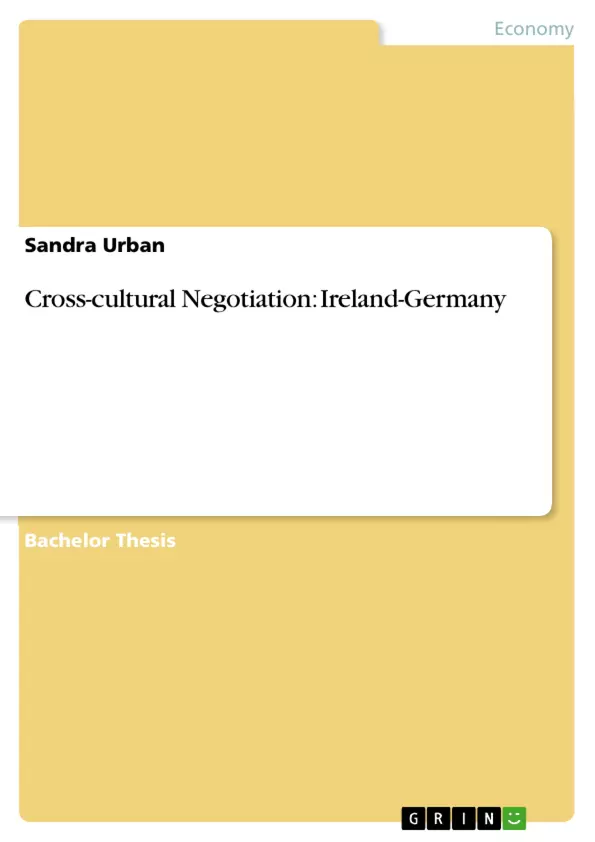Why do business negotiations often go wrong, although English is a widely and well spoken business language? Successful communication depends not only on the level of language; it is predetermined by the cultural knowledge, values and norms. Only when going abroad or meeting other cultures, people may step out of their selfreference criteria and are able to become aware of their own as well as the other’s culture. Everything that used to be normal with regarding to behaviour, attitude and values, and therefore someone was unaware of in their own culture, suddenly becomes strangely embedded in a newly occurring situation.
In spite of a huge amount of literature available about cross-cultural communication, there is little useful information, which is applicable to practical and specific situations like Irish-German negotiations. Especially, it is very difficult to acquire empirical data from negotiation processes as the influences of a third person have a considerable effect on the other communication partners’ actions and thus the value of the process is degraded.
The usage of cultural dimensions from Hofstede, Trompenaars and Hall are widely quoted and used for putting cultures into categories. In the meantime, these dimensions lack examples regarding the behaviour of cultures in certain situations. Mostly, they fail to explain the reasons for cultural behaviour, which refer to the underlying values, norms and beliefs. In addition to some of these dimensions, I will make use of communication styles and social custom in order to describe likely situation where tension between Irish and German negotiations can arise. But what is more, I will try to explain the reasons for these incidents. These explanations should give the reader a further understanding of both cultures’ values. As I am a Germannative speaker, there may be a little bias in the explanations regarding the German cultural values.
Table of Contents
- 1 INTRODUCTION
- 2 CULTURE.
- 2.1 Defining culture.
- 2.1.1 A general Definition.
- 2.1.2 Geographic and linguistic areas.
- 2.1.3 Intellectual styles...
- 2.2 Developing a cultural consciousness
- 2.2.1 The collective mind.
- 2.2.2 Cultural identity...
- 2.2.2 The need for understanding diversity.
- 2.3 Culturally Determined Behaviour
- 2.3.1 Applying Schein's Iceberg Model to management
- 2.3.2 Applying Hofstede's dimensions to management.
- 2.3.3 Applying Duelfer's layer model to management..
- 2.1 Defining culture.
- 3 CROSS-CULTURAL COMMUNICATION
- 3.1 Perception
- 3.1.1 Selection of information.
- 3.1.2 Interdependence between experiences and expectations.
- 3.1.3 Stereotypes and prejudices.
- 3.2 The \"third\" culture
- 3.2.1 Creating a \"third\" culture.
- 3.2.2 Misinterpretations...
- 3.2.3 Avoiding misunderstandings .
- 3.1 Perception
- 4 IRISH-GERMAN NEGOTIATION
- 4.1 Communication styles.
- 4.1.1 Time
- 4.1.2 Directness vs. Indirectness
- 4.2 Social customs...
- 4.2.1 Relationships.
- 4.2.2 Greetings and Addressing
- 4.2.3 Humour
- 4.3 Cultural dimensions
- 4.3.1 Low-context vs. high-context cultures.
- 4.3.2 Universalism vs. Particularism.
- 4.3.3 Uncertainty Avoidance
- 4.1 Communication styles.
Objectives and Key Themes
This dissertation analyzes the cultural differences between Ireland and Germany, with a specific focus on the implications for cross-cultural negotiation. The main objective is to provide an understanding of the cultural factors that influence communication and negotiation processes between individuals from these two countries.- Cultural definitions and frameworks
- Cultural consciousness and identity
- Culturally determined behavior in management
- Cross-cultural communication and perception
- Negotiation styles and cultural dimensions
Chapter Summaries
The first chapter introduces the topic of cross-cultural negotiation and the specific focus on Ireland and Germany. Chapter two defines culture and explores its different dimensions, including cultural consciousness, identity, and the role of cultural frameworks in understanding behavior. The chapter further examines the application of various models, such as Schein's Iceberg Model and Hofstede's dimensions, to understand cultural differences in management. Chapter three delves into the complexities of cross-cultural communication, highlighting the importance of perception, stereotypes, and the development of a "third" culture. Chapter four focuses on Irish-German negotiation, exploring differences in communication styles, social customs, and the impact of cultural dimensions on negotiation processes.Keywords
This dissertation focuses on cross-cultural negotiation, cultural differences, Ireland, Germany, communication styles, social customs, cultural dimensions, Schein's Iceberg Model, Hofstede's dimensions, and the "third" culture.- Quote paper
- Sandra Urban (Author), 2004, Cross-cultural Negotiation: Ireland-Germany, Munich, GRIN Verlag, https://www.grin.com/document/35606



